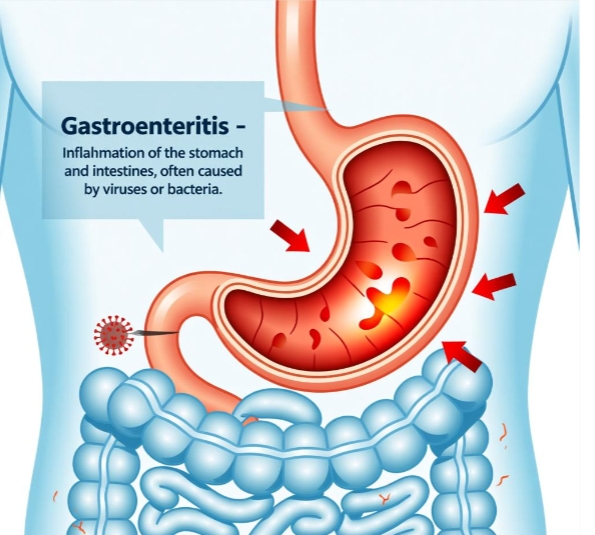a plain-language professional brief
Gastroenteritis doesn’t “fall from the sky.” It happens when the lining of your stomach and intestines is overwhelmed by one or more “attack factors.” Below are the common routes and culprits, followed by a one-page table so you can spot your own risk points at a glance.
1. Microbes: public enemy No. 1
- Viruses – norovirus, rotavirus, adenovirus; spread faeco-orally or by droplets; famous for cruise-ship, school or nursing-home outbreaks.
- Bacteria – Salmonella, pathogenic E. coli, Shigella, Campylobacter; linked to under-cooked poultry, eggs, raw seafood or contaminated water.
- Parasites – Giardia, Cryptosporidium; hide in wild water, swimming pools or pet fur and can cause weeks of diarrhoea.
2. Chemical & drug injury: self-inflicted damage
- Spirits, strong tea/coffee or super-spicy hot-pot scald the mucosa directly.
- Regular NSAIDs (aspirin, ibuprofen, diclofenac) weaken the protective barrier and let gastric acid leak in.
- Broad-spectrum antibiotics wipe out friendly flora, opening the door for C. difficile and pseudomembranous colitis.
3. Eating pattern: the stomach hates “feast-and-famine”
- One huge meal → acid overshoot and delayed emptying.
- Skip the next two meals → bile stasis and reflux. Repeat the cycle and mucosal inflammation is guaranteed.
4. Reflux & motility disorders: back-flow from the “drain”
Post-surgical anatomy, gall-bladder disease or chronic constipation can drive bile and pancreatic juice backward into the stomach; if the pylorus is lax, the mix reaches the oesophagus and creates a double acid–alkali burn.
5. Stress & psyche: the brain writes its worry on the gut
Major surgery, trauma, overnight deadlines or chronic anxiety reduce gastric mucosal blood flow and mucus secretion while raising acid output—perfect conditions for erosions and bleeding.
6. Auto-immunity & IBD: friendly fire
Auto-antibodies against parietal cells lead to chronic atrophic gastritis; Crohn’s or ulcerative colitis can ulcerate any part of the GI tract. These “non-infectious” forms tend to relapse for years.
7. Age & radiation: time and the environment gang up
After 60 the stomach makes less acid but also repairs itself more slowly; pelvic or abdominal radiotherapy and some chemo drugs can cause a direct radiation enteritis with diarrhoea and tenesmus.
One-page risk snapshot
| Attack type | Usual scene / source | Typical onset | Who’s most at risk |
|---|---|---|---|
| Viral | Cruise ships, nurseries, deli salads | Acute watery diarrhoea & vomiting, peak 48 h | Children, elderly, dormitory residents |
| Bacterial | Runny eggs, rare beef, tap water | Abdominal pain + fever, bloody mucus | Raw-food fans, travellers |
| Parasitic | Streams, pet bowls, pools | Diarrhoea >2 weeks, bloating, gas | Campers, toddlers |
| Drugs / chemicals | Painkillers, antibiotics, spirits | Vague pain → erosions → black stools | Chronic users, heavy drinkers |
| Binge–starve cycle | All-you-can-eat hot-pot plus skipped meals | Upper pain, acid reflux, belching | Students, busy office staff |
| Bile reflux | Post-GB surgery, chronic constipation | Burning, bitter taste, worse after meals | Post-op patients, pregnant women |
| Psychological stress | Exams, overtime, sleep debt | Stomach ache + irregular bowel | High-pressure jobs, anxious personalities |
| Auto-immune | No clear trigger, often with tongue pain & anaemia | Chronic atrophy, fatigue | Middle-aged women, family history |
| Radiation injury | Pelvic radiotherapy, chemotherapy | Tenesmus, mucus-blood stools | Cancer patients |
